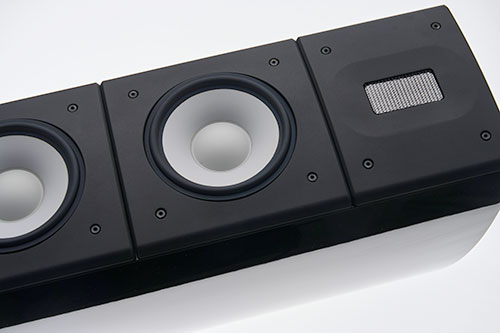
But let's throw a brief look back at the switchable input impedance: Of course, MSB makes a point of ensuring that the power amplifiers harmonise particularly well with the D/A converters that established the company's excellent reputation. As described in the report on the Reference DAC, the outputs of the one, two or four ladder DAC modules, depending on the model, are followed neither by a current/voltage converter nor by a buffer circuit. The result is on the one hand a very short and puristic signal path, but on the other hand a not particularly high output voltage correlating with a quite powerful output current instead. This is not worth considering when using a preamplifier with a high-impedance input. However, in order to drive a power amplifier directly and perhaps also via longer signal cables, it might be useful to rely on current matching instead of voltage matching between the converter and the downstream power amplifier. This also has the advantage of minimising the sonic influence of the connecting cables. On the M500, MSB therefore provides an impedance of 75 ohms for the Select and Reference DACs, 300 ohms for the other proprietary converters and 1.2 kilohms for preamps from other manufacturers. But even this value might not be the ideal match for i.e. tube preamps with a quite high output impedance. With Einstein's The Preamp, however, I chose 300 ohms. Its developer, Rolf Weiler, is not averse to the principle of current matching and has therefore treated the preamp to a very current-potent output stage. The lucky owners of an MSB converter who prefer a short signal path and want to get by without an additional preamplifier cannot have better game partners for their noble DACs - also from a technical point of view - than MSB power amplifiers with matched input impedance. In addition, the M500s also feature a three-step switch for selecting the gain factor. This ensures that the passive volume control of the MSB DACs can always be operated in the optimal range, even on speakers with very different efficiencies.

Naturally, I started enjoying the MSB gear first as a full set for a few days, before I took a closer look at the Reference DAC on its own and listened to its various input options in familiar surroundings - i.e. in combination with Einstein's The Poweramp and sometimes with, sometimes without The Preamp. I had speculated that the Reference DAC could remain in my listening room until I gained sufficient experience with the M500s, but, unfortunately, this went out not to be the case. Jürgen Sachweh, head of Hifi2Die4 and thus MSB distributor for Germany, required the converter back for a demonstration. So I quickly compared it once more to the M500s connected to my digital chain, i.e. the Aries G2.1, the M-Scaler, the DAVE including batteries, and linear power supplies alternatively, in conjunction with the Einstein preamplifier indispensable in my set-up, to get an idea of how much enjoyment I would have to forego if the M500s were forced to do without the Reference DAC. Admittedly, the Auralic-Chord-Einstein combo spoils with a touch of euphony - or more trivially: a minimal loudness effect. The slight emphasis on the low and high frequencies can be quite appealing in some recordings, but unfortunately also adds a touch of roughness to the latter. The MSB, on the other hand, intrigues with smooth and always pleasant highs, proves to be a prime example of neutrality and tonal balance and shines with an even wider and deeper soundstage. Thus, it remains strictly committed to the ideal of high fidelity, but at the same time offers the highest grade of musical enjoyment. Blessed are those who can afford to keep this digital epitome of dreams in their listening room after an extensive testing.
But let's now move to the M500s. Regardless of whether the Reference DAC or my digital system in unity with Einstein's preamplifier supplied the signal, every time I switched from the Poweramp to the Californian monos and back - and there have been quite a few of these interplays in the last three months, even though there was no direct comparison yet - the impression that the MSBs help the playback to have a more sonorous and solid low-frequency foundation became increasingly obvious. The Poweramp delivers a touch more energy in the upper frequency ranges, which sometimes makes it appear slightly more nervous. Nevertheless, the M500s seem to perform a shade quicker. But before I compare the power amps more intensively, I'll first take care of the operating conditions of the monos: Since they draw their power via an IEC-19 socket, but the six-metre-long mains cables required for connection to the Audioquest Niagara power conditioner with its sound-enhancing Power Correction circuitry being fitted with IEC-16 plugs, the only way out was to do without the Niagara's capabilities or to use the existing cables with an Isotek IEC C13 to IEC C20 adapter. I finally opted for the latter.

























 |
|




















































































